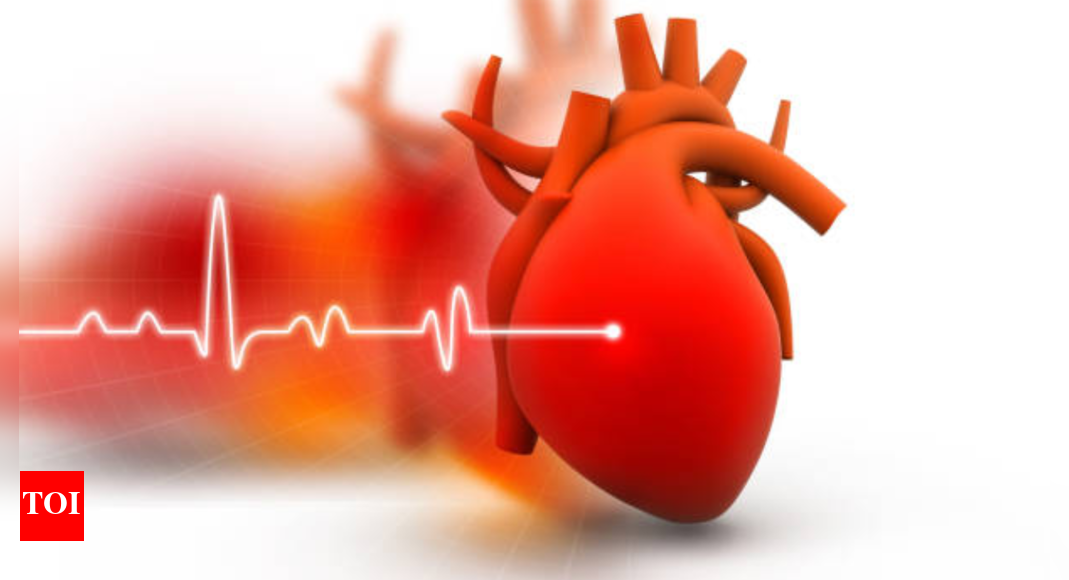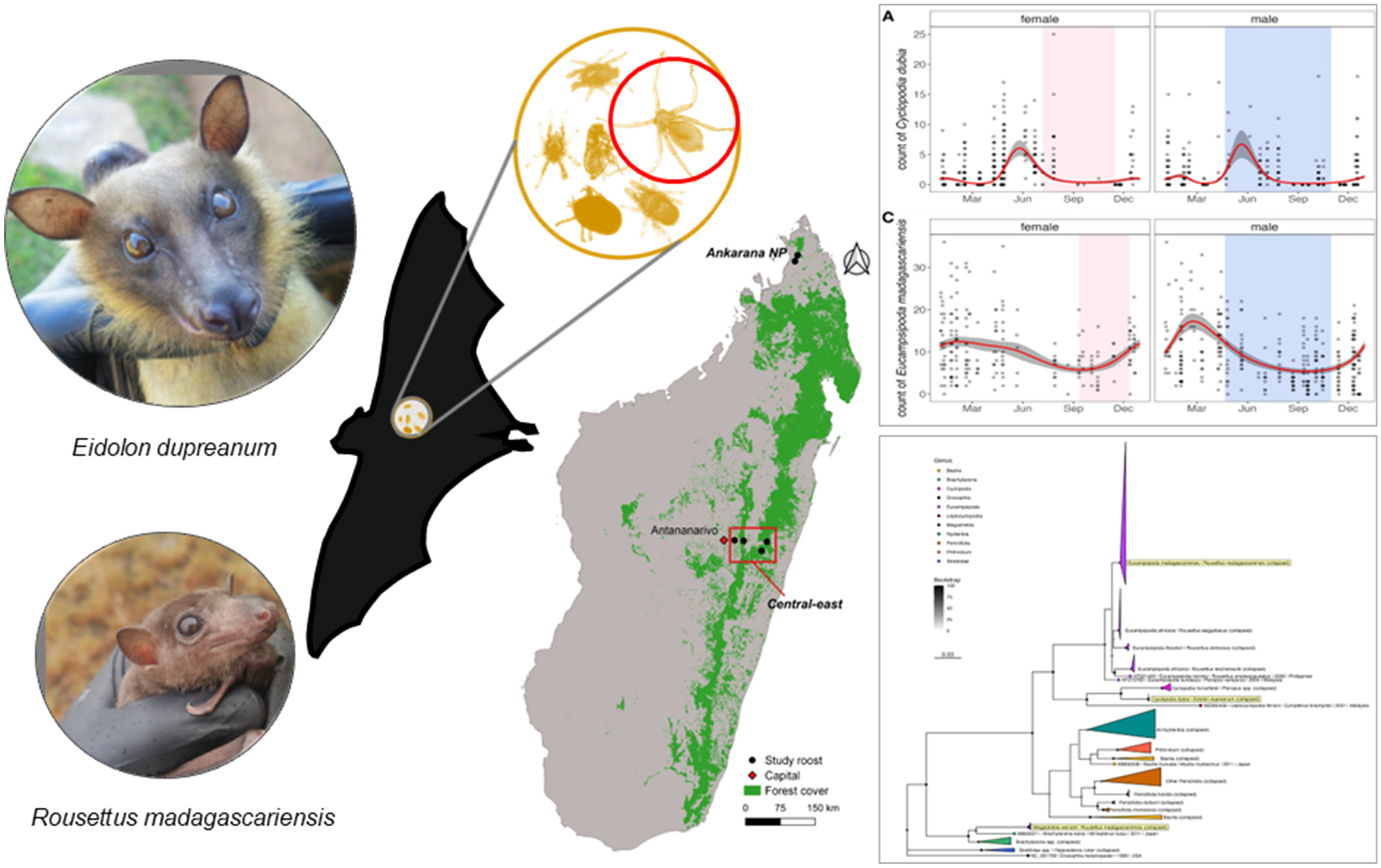Guth S, Mollentze N, Renault K, Streicker DG, Visher E, Boots M, et al. Bats host the most virulent—but not the most dangerous—zoonotic viruses. Proc Natl Acad Sci USA. 2022;119:e2113628119.
CAS
PubMed
PubMed Central
Google Scholar
Schountz T, Baker ML, Butler J, Munster V. Immunological control of viral infections in bats and the emergence of viruses highly pathogenic to humans. Front Immunol. 2017;8:1098.
PubMed
PubMed Central
Google Scholar
Ramasindrazana B, Goodman SM, Dsouli N, Gomard Y, Lagadec E, Randrianarivelojosia M, et al. Polychromophilus spp. (Haemosporida) in Malagasy bats: host specificity and insights on invertebrate vectors. Malar J. 2018;17:318.
PubMed
PubMed Central
Google Scholar
Brook CE, Bai Y, Dobson AP, Osikowicz LM, Ranaivoson HC, Zhu Q, et al. Bartonella spp. in fruit bats and blood-feeding ectoparasites in Madagascar. PLoS Negl Trop Dis. 2015;10:e0003532.
Google Scholar
Meteyer CU, Barber D, Mandl JN. Pathology in euthermic bats with white nose syndrome suggests a natural manifestation of immune reconstitution inflammatory syndrome. Virulence. 2012;3:1–6. https://doi.org/10.4161/viru.2230.
Google Scholar
Field KA, Johnson JS, Lilley TM, Reeder SM, Rogers J, Behr MJ, et al. The white-nose syndrome transcriptome: activation of anti-fungal host responses in wing tissue of hibernating little brown Myotis. PLoS Pathog. 2015;11:1–29.
Google Scholar
Lord JS, Parker S, Parker F, Brooks DR. Gastrointestinal helminths of pipistrelle bats (Pipistrellus pipistrellus/Pipistrellus pygmaeus) (Chiroptera: Vespertilionidae) of England. Parasitology. 2012;139:366–74.
PubMed
Google Scholar
Brook CE, Dobson AP. Bats as “special” reservoirs for emerging zoonotic pathogens. Trends Microbiol. 2015;23:172–80.
CAS
PubMed
PubMed Central
Google Scholar
Dittmar K, Porter ML, Murray S, Whiting MF. Molecular phylogenetic analysis of nycteribiid and streblid bat flies (Diptera: Brachycera, Calyptratae): implications for host associations and phylogeographic origins. Mol Phylogenet Evol. 2006;38:155–70.
CAS
PubMed
Google Scholar
Dick CW, Patterson BD. Bat flies—obligate ectoparasites of bats. In: Morand S, Krasnov BR, Poulin R, editors. Micromammals and microparasites: from evolutionary ecology to management. Tokyo: Springer; 2006. p. 179–94.
Google Scholar
Fitze PS, Clobert J, Richner H. Long-term life history consequences of ectoparasite-modulated growth and development. Ecology. 2004;85:2018–26.
Google Scholar
Fitze PS, Tschirren B, Richner H. Life history and fitness consequences of ectoparasites. J Anim Ecol. 2004;73:216–26.
Google Scholar
Szentiványi T, Christe P, Glaizot O. Bat flies and their microparasites: current knowledge and distribution. Front Vet Sci. 2019;6:115.
PubMed
PubMed Central
Google Scholar
Zabashta MV, Orlova MV, Pichurina NL, Khametova AP, Romanova LV, Borodina TN, et al. Participation of bats (Chiroptera, Mammalia) and their ectoparasites in circulation of pathogens of natural focal infections in the south of Russia. Entmol Rev. 2019;99:513–21.
Google Scholar
Gardner R, Molyneux D. Trypanosoma (Megatrypanum) incertum from Pipistrellus pipistrellus: development and transmission by cimicid bugs. Parasitology. 1988;96:433–47.
PubMed
Google Scholar
Barnabe C, Brisse S, Tibayrenc M. Phylogenetic diversity of bat trypanosomes of subgenus Schizotrypanum based on multilocus enzyme electrophoresis, random amplified polymorphic DNA, and cytochrome b nucleotide sequence analyses. Infect Genet Evol. 2003;2:201–8.
CAS
PubMed
Google Scholar
Lima L, Espinosa-Álvarez O, Pinto CM, Cavazzana M, Pavan AC, Carranza JC, et al. New insights into the evolution of the Trypanosoma cruzi clade provided by a new trypanosome species tightly linked to Neotropical Pteronotus bats and related to an Australian lineage of trypanosomes. Parasit Vectors. 2015;8:657.
PubMed
PubMed Central
Google Scholar
Ramírez JD, Tapia-Calle G, Muñoz-Cruz G, Poveda C, Rendón LM, Hincapié E, et al. Trypanosome species in neo-tropical bats: biological, evolutionary and epidemiological implications. Infect Genet Evol. 2014;22:250–6.
PubMed
Google Scholar
Paterson WB, Woo PTK. The development of the culture and bloodstream forms of three Trypanosoma (Schizotrypanum) spp. (Protista: Zoomastigophorea) from bats in Cimex lectularius (Hemiptera: Cimicidae). Can J Zool. 1984;62:1581–7.
Google Scholar
Do Amaral RB, Lourenço EC, Famadas KM, Garcia AB, Machado RZ, André MR. Molecular detection of Bartonella spp and Rickettsia spp in bat ectoparasites in Brazil. PLoS ONE. 2018;13:e0198629.
PubMed
PubMed Central
Google Scholar
Sándor AD, Földvári M, Krawczyk AI, Sprong H, Corduneanu A, Barti L, et al. Eco-epidemiology of novel Bartonella genotypes from parasitic flies of insectivorous bats. Microb Ecol. 2018;76:1076–88.
PubMed
Google Scholar
Leulmi H, Aouadi A, Bitam I, Bessas A, Benakhla A, Raoult D, et al. Detection of Bartonella tamiae, Coxiella burnetii and rickettsiae in arthropods and tissues from wild and domestic animals in northeastern Algeria. Parasites Vectors. 2016;9:27.
PubMed
PubMed Central
Google Scholar
Stuckey MJ, Chomel BB, Galvez-Romero G, Olave-Leyva JI, Obregón-Morales C, Moreno-Sandoval H, et al. Bartonella infection in hematophagous, insectivorous, and phytophagous bat populations of central Mexico and the Yucatan Peninsula. Am Soc Trop Med Hyg. 2017;97:413–22.
CAS
Google Scholar
Hornok S, Kovács R, Meli ML, Gönczi E, Hofmann-Lehmann R, Kontschán J, et al. First detection of Bartonellae in a broad range of bat ectoparasites. Vet Microbiol. 2012;3:541–3.
Google Scholar
Fagre AC, Islam A, Reeves WK, Kading RC, Plowright RK, Gurley ES, et al. Bartonella infection in fruit bats and bat flies, Bangladesh. Microb Ecol. 2023;86:2910–22.
PubMed
Google Scholar
Reeves WK, Loftis AD, Gore JA, Dasch GA. Molecular evidence for novel Bartonella species in Trichobius major (Diptera : Streblidae) and Cimex adjunctus (Hemiptera: Cimicidae) from two southeastern bat caves, U.S.A. J Vector Ecol. 2005;30:339–41.
PubMed
Google Scholar
Billeter SA, Hayman DTS, Peel AJ, Baker K, Wood JLN, Cunningham A, et al. Bartonella species in bat flies (Diptera: Nycteribiidae) from western Africa. Parasitology. 2012;139:324–9.
CAS
PubMed
Google Scholar
Morse SF, Olival KJ, Kosoy M, Billeter SA, Patterson BD, Dick CW, et al. Global distribution and genetic diversity of Bartonella in bat flies (Hippoboscoidea, Streblidae, Nycteribiidae). Infect Genet Evol. 2012;12:1717–23.
PubMed
Google Scholar
Loftis AD, Gill JS, Schriefer ME, Michael L, Eremeeva ME, Gilchrist MJR, et al. Detection of Rickettsia, Borrelia, and Bartonella in Carios kelleyi (Acari: Argasidae). Vector-borne Diseases, Surveillance, and Preventiion. 2005;42:473–80.
CAS
Google Scholar
Socolovschi C, Kernif T, Raoult D, Parola P. Borrelia, Rickettsia, and Ehrlichia species in bat ticks, France, 2010. Emerg Infect Dis. 2012;18:1966–75.
CAS
PubMed
PubMed Central
Google Scholar
Cutler SJ, Ruzic-Sabljic E, Potkonjak A. Emerging borreliae—expanding beyond Lyme borreliosis. Mol Cell Probes. 2017;31:22–7.
CAS
PubMed
Google Scholar
Hubbard MJ, Baker AS, Cann KJ. Distribution of Borrelia burgdorferi s.l. spirochaete DNA in British ticks (Argasidae and Ixodidae) since the 19th Century, assessed by PCR. Med Vet Entomol. 1998;12:89–97.
CAS
PubMed
Google Scholar
Goodman SM. Les chauves-souris de Madagascar. Antananarivo: Association Vahatra; 2011. (in French).
Google Scholar
Brook CE, Ranaivoson HC, Broder CC, Cunningham AA, Héraud JM, Peel AJ, et al. Disentangling serology to elucidate henipa- and filovirus transmission in Madagascar fruit bats. J Anim Ecol. 2019;88:1001–16.
PubMed
PubMed Central
Google Scholar
Iehlé C, Razafitrimo G, Razainirina J, Andriaholinirina N, Goodman SM, Faure C. Henipavirus and Tioman virus antibodies in Pteropodid bats, Madagascar. Emerg Infect Dis. 2007;13:159–61.
PubMed
PubMed Central
Google Scholar
Kettenburg G, Kistler A, Ranaivoson HC, Ahyong V, Andrianiaina A, Andry S, et al. Full genome Nobecovirus sequences from Malagasy fruit bats define a unique evolutionary history for this coronavirus clade. Front Public Health. 2022;10:786060.
PubMed
PubMed Central
Google Scholar
Madera S, Kistler A, Ranaivoson HC, Ahyong V, Andrianiaina A, Andry S, et al. Discovery and genomic characterization of a novel henipavirus, Angavokely virus, from fruit bats in Madagascar. J Virol. 2022;96:e00921-e922.
PubMed
PubMed Central
Google Scholar
Horigan S, Kettenburg G, Kistler A, Ranaivoson HC, Andrianiaina A, Andry S, et al. Detection, characterization, and phylogenetic analysis of novel astroviruses from endemic Malagasy fruit bats. Virol J. 2024;21:195.
PubMed
PubMed Central
Google Scholar
Lebarbenchon C, Ramasindrazana B, Joffrin L, Bos S, Lagadec E, Le Minter G, et al. Astroviruses in bats, Madagascar. Emerg Microb Infect. 2017;6:e58.
Google Scholar
Mélade J, Wieseke N, Ramasindrazana B, Flores O, Lagadec E, Gomard Y, et al. An eco-epidemiological study of Morbilli-related paramyxovirus infection in Madagascar bats reveals host-switching as the dominant macro-evolutionary mechanism. Sci Rep. 2016;6:23752.
PubMed
PubMed Central
Google Scholar
Mélade J, McCulloch S, Ramasindrazana B, Lagadec E, Turpin M, Pascalis H, et al. Serological evidence of lyssaviruses among bats on Southwestern Indian Ocean Islands. PLoS ONE. 2016;11:e0160553.
PubMed
PubMed Central
Google Scholar
Wilkinson DA, Mélade J, Dietrich M, Ramasindrazana B, Soarimalala V, Lagadec E, et al. Highly diverse Morbillivirus-related paramyxoviruses in the wild fauna of southwestern Indian Ocean islands: evidence of exchange between introduced and endemic small mammals. J Virol. 2014;88:8268–77.
PubMed
PubMed Central
Google Scholar
Razanajatovo NH, Nomenjanahary LA, Wilkinson DA, Razafimanahaka JH, Goodman SM, Jenkins RK, et al. Detection of new genetic variants of Betacoronaviruses in endemic frugivorous bats of Madagascar. Virol J. 2015;12:1–8.
CAS
Google Scholar
Reynes JM, Andriamandimby SF, Razafitrimo GM, Razainirina J, Jeanmaire EM, Bourhy H, et al. Laboratory surveillance of rabies in humans, domestic animals, and bats in Madagascar from 2005 to 2010. Adv Prev Med. 2011;2011:727821.
PubMed
PubMed Central
Google Scholar
Ranaivoson HC, Héraud JM, Goethert HK, Telford SR III, Rabetafika L, Brook CE. Babesial infection in the Madagascan flying fox, Pteropus rufus É. Geoffroy. Parasit Vectors. 2019;12:1–13.
Google Scholar
Lagadec E, Gomard Y, Guernier V, Dietrich M, Pascalis H, Temmam S, et al. Pathogenic Leptospira spp. in bats, Madagascar and Union of the Comoros. Emerg Infect Dis. 2012;18:1696–8.
PubMed
PubMed Central
Google Scholar
Gomard Y, Dietrich M, Wieseke N, Ramasindrazana B, Lagadec E, Goodman SM, et al. Malagasy bats shelter a considerable genetic diversity of pathogenic Leptospira suggesting notable host-specificity patterns. FEMS Microbiol Ecol. 2016;92:1–12.
Google Scholar
Ramasindrazana B, Dellagi K, Lagadec E, Randrianarivelojosia M, Goodman SM, Tortosa P. Diversity, host specialization, and geographic structure of filarial nematodes infecting Malagasy bats. PLoS ONE. 2016;11:e0145709.
PubMed
PubMed Central
Google Scholar
Kettenburg G, Ranaivoson HC, Andrianianina A, Andry S, Henry AR, Davis RL, et al. Picornaviridae and Caliciviridae diversity in Madagascar fruit bats is driven by cross-continental genetic exchange. BioRxiv. 2025. https://doi.org/10.1101/2024.12.31.630946.
PubMed
PubMed Central
Google Scholar
Gonzalez FL, Ranaivoson HC, Andrianiaina A, Andry S, Raharinosy V, Randriambolamanantsoa TH, et al. Genomic characterization of novel bat kobuviruses in Madagascar: implications for viral evolution and zoonotic risk. BioRxiv. 2024. https://doi.org/10.1101/2024.12.24.630179.
PubMed
PubMed Central
Google Scholar
Tortosa P, Dsouli N, Gomard Y, Ramasindrazana B, Dick CW, Goodman SM. Evolutionary history of Indian Ocean nycteribiid bat flies mirroring the ecology of their hosts. PLoS ONE. 2013;8:e75215.
CAS
PubMed
PubMed Central
Google Scholar
Theodor O. New species and new records of Nycteribiidae from the Ethiopian, Oriental and Pacific regions. Parasitology. 1968;58:247–76.
Google Scholar
Theodor O. The Nycteribiidae of the Ethiopian region and Madagascar. Parasitology. 1957;47:457–543.
CAS
PubMed
Google Scholar
Theodor O. On the genus Eucampsipoda Kol. and Dipseliopoda n.g. (Nycteribiidae, Diptera). Parasitology. 1955;45:195–229.
CAS
PubMed
Google Scholar
Theodor O. A revision of the genus Cyclopodia (Nycteribiidae, Diptera). Parasitology. 1959;49:242–308.
CAS
PubMed
Google Scholar
Ramasindrazana B, Goodman SM, Gomard Y, Dick CW, Tortosa P. Hidden diversity of Nycteribiidae (Diptera) bat flies from the Malagasy region and insights on host-parasite interactions. Parasites Vectors. 2017;10:630.
PubMed
PubMed Central
Google Scholar
Maa TC. Records and descriptions of Nycteribiidae and Streblidae (Diptera). Pacific Insects. 1962;4:417–36.
Google Scholar
Maa TC. Review of the Streblidae (Diptera) parasitic on Megachiropteran bats. Pac Insects Monogr. 1971;28:213–43.
Google Scholar
Jobling B. Description of two new species of Ascodipteron from Africa and one species of Nycteribosca from Madagascar (Diptera, Streblidae). Parasitology. 1952;42:126–35.
CAS
PubMed
Google Scholar
Wilkinson DA, Duron O, Cordonin C, Gomard Y, Ramasindrazana B, Mavingui P, et al. The bacteriome of bat flies (Nycteribiidae) from the Malagasy region: a community shaped by host ecology, bacterial transmission mode, and host-vector specificity. Appl Environ Microbiol. 2016;82:1778–88.
CAS
PubMed
PubMed Central
Google Scholar
Rajemison AFI, Lalarivoniaina OSN, Goodman SM. Bat flies (Diptera: Nycteribiidae, Streblida) parasitising Rousettus madagascariensis (Chiroptera: Pteropodidae) in the Parc National d’Ankarana, Madagascar: Species diversity, rates of parasitism, and sex ratios. African Entomology. 2017;25:72–85.
Google Scholar
Rajemison FI, Lalarivoniaina OSN, Andrianarimisa A, Goodman SM. Host-parasite relationships between a Malagasy fruit bat (Pteropodidae) and associated bat fly (Diptera: Nycteribiidae): seasonal variation of host body condition and the possible impact of parasite abundance. Acta Chiropterologica. 2017;19:229–38.
Google Scholar
Andrianiaina A, Andry S, Gentles A, Guth S, Héraud JM, Ranaivoson HC, et al. Reproduction, seasonal morphology, and juvenile growth in three Malagasy fruit bats. J Mammal. 2022;103(6):1397–408. https://doi.org/10.1101/2021.10.28.466299.
PubMed
PubMed Central
Google Scholar
Rasoarimanana VMC, Goodman SM, Rajemison B, Lebarbenchon C, Ramanantsalama RV. Fecal analysis of an endemic Malagasy fruit bat (Rousettus madagascariensis, Pteropodidae): evidence of ectoparasite consumption and insectivory. Acta Chiropterologica. 2024;25:257–63.
Google Scholar
Ramanantsalama RV, Ganzhorn JU, Vololona J, Goodman SM. Bat flies: source of supplement nutrients for an endemic Malagasy fruit bat. Trop Zool. 2022;35(1–2). https://doi.org/10.4081/tz.2022.107.
Google Scholar
Ramanantsalama RV, Andrianarimisa A, Raselimanana AP, Goodman SM. Rates of hematophagous ectoparasite consumption during grooming by an endemic Madagascar fruit bat. Parasit Vectors. 2018;11:330.
PubMed
PubMed Central
Google Scholar
Whitaker JO, Ritzi CM, Dick CW. Collecting and preserving bat ectoparasites for ecological study. In: Ecological and behavioral methods for the study of bats. 2nd ed. Baltimore: Johns Hopkins University Press; 2009. p. 806–27.
Google Scholar
Lindquist EE, Evans GO. Taxonomic concepts in the Ascidae, with a modified setal nomenclature for the idiosoma of the Gamasina (Acarina: Mesostigmata). Memoirs Entomol Soc Canada. 1965;97:5–66.
Google Scholar
Stanykovich MK. Keys to the gamasid mites (Acari, Parasitiformes, Mesostigmata, Macronyssoidea et Laelaptoidea) parasitizing bats (Mammalia, Chiroptera) from Russia and adjacent countries. Rudolstadter Nat Hist. 1997;7:13–46.
Google Scholar
Folmer O, Black M, Hoeh W, Lutz R, Vrijenhoek R. DNA primers for amplification of mitochondrial cytochrome c oxidase subunit I from diverse metazoan invertebrates. Mol Mar Biol Biotechnol. 1994;3:294–9.
CAS
PubMed
Google Scholar
Whiting MF. Mecoptera is paraphyletic: multiple genes and phylogeny of Mecoptera and Siphonaptera. Zoolog Scr. 2002;31:93–104.
Google Scholar
Bybee SM, Taylor SD, Riley Nelson C, Whiting MF. A phylogeny of robber flies (Diptera: Asilidae) at the subfamilial level: molecular evidence. Mol Phylogenet Evol. 2004;30:789–97.
CAS
PubMed
Google Scholar
Ratnasingham S, Hebert PD. BOLD: The barcode of life data system. Mol Ecol Notes. 2007;7:355–64.
CAS
PubMed
PubMed Central
Google Scholar
Team RC. R: a language and environment for statistical computing. Vienna: R Foundation for Statistical Computing; 2019.
Google Scholar
Dormann CF, Gruber B, Fründ J. Introducing the bipartite Package: analysing ecological networks. R News. 2008;8:8–11.
Google Scholar
Wood SN. mgcv: GAMs and generalized ridge regression for R. R News. 2001;1:20–4.
Google Scholar
Edelson R, Gelbord J, Cackett E, Connolly S, Done C, Fausnaugh M, et al. Swift monitoring of NGC 4151: evidence for a second X-Ray/UV reprocessing. ApJ. 2017;840:41.
Google Scholar
Attaullah, Ali S, Javid A, Imran M, Khan TM, Phelps K, et al. Phylogenetic relationships of a novel bat fly species infesting the geographically widespread Old World fruit bat, Rousettus leschenaultii, in Southern Asia. Parasitol Res. 2023;122:2101–7.
CAS
PubMed
Google Scholar
Poon ESK, Chen G, Tsang HY, Shek CT, Tsui WC, Zhao H, et al. Species richness of bat flies and their associations with host bats in a subtropical East Asian region. Parasites Vectors. 2023;16:37.
PubMed
PubMed Central
Google Scholar
Katoh K, Rozewicki J, Yamada KD. MAFFT online service: multiple sequence alignment, interactive sequence choice and visualization. Brief Bioinform. 2018;20:1160–6.
Google Scholar
Kuraku S, Zmasek CM, Nishimura O, Katoh K. aLeaves facilitates on-demand exploration of metazoan gene family trees on MAFFT sequence alignment server with enhanced interactivity. Nucleic Acids Res. 2013;41:22–8.
Google Scholar
Darriba D, Posada D, Kozlov AM, Stamatakis A, Morel B, Flouri T. ModelTest-NG: a new and scalable tool for the selection of DNA and protein evolutionary models. Mol Biol Evol. 2020;37:291–4.
CAS
PubMed
Google Scholar
Kozlov AM, Darriba D, Flouri T, Morel B, Stamatakis A. RAxML-NG: a fast, scalable and user-friendly tool for maximum likelihood phylogenetic inference. Bioinformatics. 2019;35:4453–5.
CAS
PubMed
PubMed Central
Google Scholar
Felsenstein J. Confidence limits on phylogenies: an approach using the bootstrap. Evolution. 1985;39:783–91.
PubMed
Google Scholar
Pattengale ND, Alipour M, Bininda-Emonds ORP, Moret BME, Stamatakis A. How many bootstrap replicates are necessary? J Comput Biol. 2010;17:337–54.
CAS
PubMed
Google Scholar
Yu G, Smith DK, Zhu H, Guan Y, Lam TTY. Ggtree: an R Package for visualization and annotation of phylogenetic trees with their covariates and other associated data. Methods Ecol Evol. 2017;8:28–36.
Google Scholar
Ramanantsalama RV, Lalarivoniaina OSN, Raselimanana AP, Goodman SM. Influence of environmental parameters on the breeding of an endemic Malagasy fruit bat, Rousettus madagascariensis (Pteropodidae). Acta Chiropterologica. 2023;24:327–42.
Google Scholar
Mutere FA. The breeding biology of equatorial vertebrates: reproduction in the fruit bat, Eidolon helvum, at latitude 0°20′N. J Zool. 1967;153:153–61.
Google Scholar
Mutere FA. The breeding biology of the fruit bat Rousettus aegyptiacus E. Geoffroy living at 0° 22’ S. Acta Trop. 1968;2:97–108.
Google Scholar
Fagir DM, Horak IG, Ueckermann EA, Bennett NC, Lutermann H. Ectoparasite diversity in the eastern rock sengis (Elephantulus myurus): the effect of seasonality and host sex. African Zoology. 2015;50:109–17.
Google Scholar
Smolinský R, Hiadlovská Z, Martínková N. Ectoparasite load increase in reproductively active sand lizards. J Vertebr Biol. 2021;70:20128.
Google Scholar
Anderson PC, Kok OB. Ectoparasites of springhares in the Northern Cape Province, South Africa. South Afr J Wildl Res. 2003;33:23–32.
Google Scholar
Pearce RD, O’Shea TJ. Ectoparasites in an urban population of Big Brown Bats (Eptesicus fuscus) in Colorado. J Parasitol. 2007;93:518–30.
PubMed
Google Scholar
Christe P, Arlettaz R, Vogel P. Variation in intensity of a parasitic mite (Spinturnix myoti) in relation to the reproductive cycle and immunocompetence of its bat host (Myotis myotis). Ecol Lett. 2000;3:207–12.
Google Scholar
Tai YL, Lee YF, Kuo YM, Kuo YJ. Effects of host state and body condition on parasite infestation of bent-wing bats. Front Zool. 2022;19:12.
PubMed
PubMed Central
Google Scholar
Ruhs EC, Kettenburg G, Andrianiaina A, Andry S, Ranaivoson HC, Grewe F, et al. Quantifying the seasonal reproductive cycle in three species of Malagasy fruit bats with implications for pathogen and population dynamics. BioRxiv. 2024. https://doi.org/10.1101/2024.08.21.608949.
Google Scholar
Christe P, Glaizot O, Evanno G, Bruyndonckx N, Devevey G, Yannic G, et al. Host sex and ectoparasites choice: preference for, and higher survival on female hosts. J Anim Ecol. 2007;76:703–10.
PubMed
Google Scholar
Zahn A, Rupp D. Ectoparasite load in European vespertilionid bats. J Zool. 2004;262:383–91.
Google Scholar
Dittmar K, Morse S, Gruwell M, Mayberry J, DiBlasi E. Spatial and temporal complexities of reproductive behavior and sex ratios: a case from parasitic insects. PLoS ONE. 2011;6:e19438.
CAS
PubMed
PubMed Central
Google Scholar
Fritz GN. Biology and ecology of bat flies (Diptera: Streblidae) on bats in the genus Carollia. J Med Entomol. 1983;20:1–10.
CAS
PubMed
Google Scholar
Marshall AG. The sex ratio in ectoparasitic insects. Ecol Entomol. 1981;6:155–74.
Google Scholar
Tlapaya-Romero L, Santos-Moreno A, Ibáñez-Bernal S. Effect of seasonality and microclimate on the variation in bat-fly load (Diptera: Streblidae) in a cave bat assemblage in a dry forest. Mammalia. 2021;85:345–54.
Google Scholar
Eriksson A, Doherty J, Fischer E, Graciolli G, Poulin R. Hosts and environment overshadow spatial distance as drivers of bat fly species composition in the Neotropics. J Biogeogr. 2020;47:736–47.
Google Scholar
Species IUCN Red List Threat. IUCN Red List. 2018. IUCN 2018. Version 2018-2.









